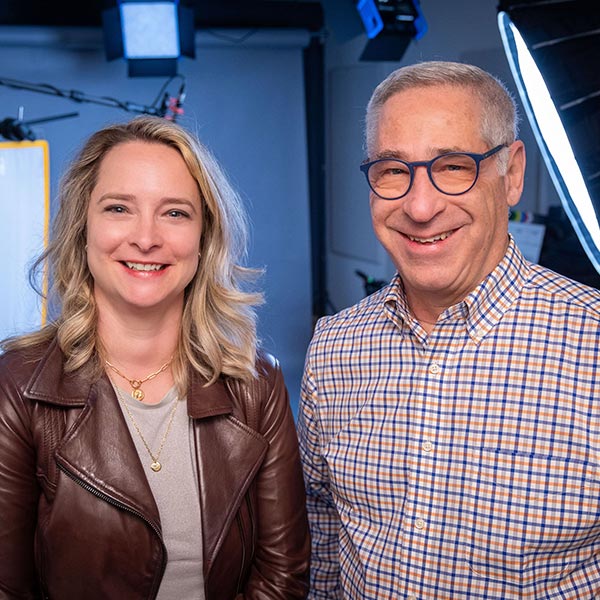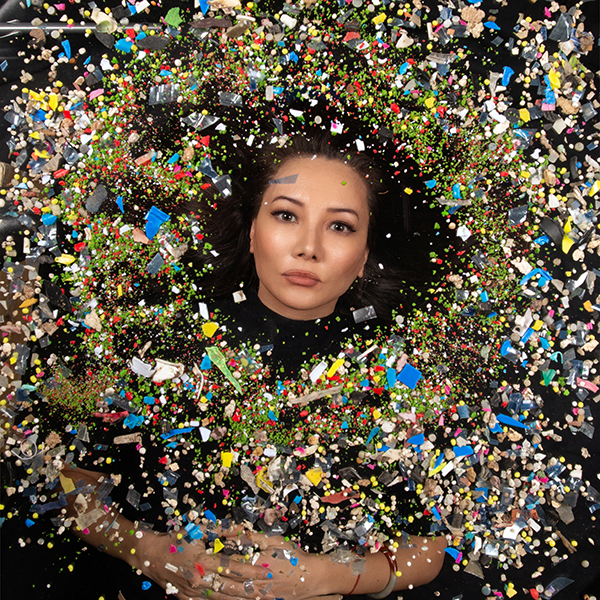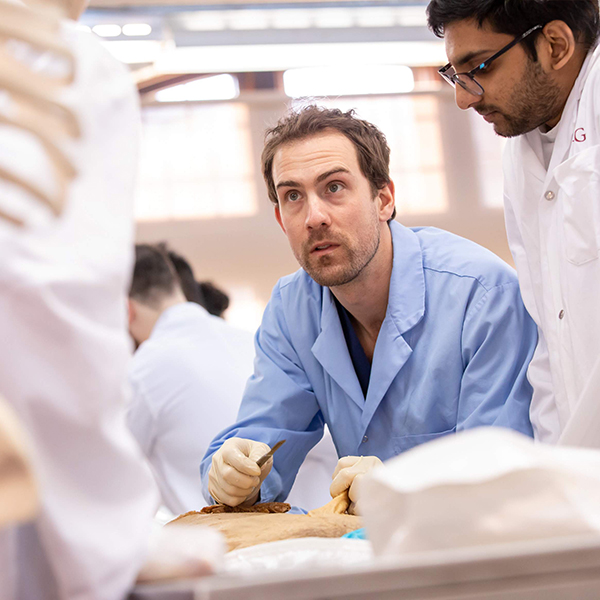“We’ve been doing a lousy job of advancing neuroscience.”
That blunt assessment, directed towards the entire field of neuroscience in an interview just a few months ago, was jarring – particularly given the source.
The words belong to Guy Rouleau, a leading authority on neurodegenerative diseases. He has played a major role in the identification of more than 20 genes associated with neurological and psychiatric illnesses. He is the director of McGill’s Montreal Neurological Institute (also known as The Neuro), one of the best-known neuroscience centres in the world.
“We just aren’t progressing quickly enough,” he says. “We need to find ways to do things differently.” And, with the recent unveiling of a series of bold new initiatives, McGill will be doing things very differently indeed.
Pick up a copy of Scientific American or Discover, and you’d probably conclude that the current state of neuroscience was quite robust. Researchers always seem to be unearthing new pieces of the puzzle that is the human brain.
Rouleau would be quick to agree that those discoveries are valuable, but he would add that they aren’t getting us where we need to go swiftly enough. We have to do a better job of fitting those puzzle pieces together. The stakes are high.
According to the World Health Organization, by the year 2040, brain diseases will kill more Canadians each year than cancer does. The non-profit Brain Canada Foundation estimates the economic toll of neurological and psychiatric illnesses in this country at $22.7 billion a year.
“As people live longer, brain diseases become more prevalent,” says Alan Evans, The Neuro’s James McGill Professor of Neurology and Neurosurgery, and Psychiatry. “People didn’t die from Alzheimer’s disease 200 years ago, because they were dead from something else long before Alzheimer’s disease could appear.
“We also know that there is such a thing as healthy aging,” says Evans, “where you can keep filling out the crossword puzzles and playing chess like a champ when you’re 95. It isn’t predetermined that you’ll begin to lose it at a certain point. We believe we can prevent neurodegeneration.”
The enigma inside our heads
For all the progress that neuroscience has made, the brain is still largely a mystery. The three pounds of squishy organic material nestled inside your skull just might be most complicated thing on this planet.
Sir Roger Penrose, the famed British mathematical physicist, once declared, “Compared to the complexity of a brain, a galaxy is just an inert lump.” Stanford University neuroscientist Stephen Smith more recently likened each of the brain’s trillions of synapses to a microprocessor.
Last fall, McGill received word that its Healthy Brains for Healthy Lives (HBHL) program would be receiving a monumental $84 million grant over a seven year period from the federal government’s Canada First Research Excellence Fund (CFREF). That money will fuel a multidisciplinary approach to neuroscience that marshals the expertise of a wide assortment of McGill experts and connects them to advances being made in the burgeoning fields of computational modelling and neuroinformatics.
At the same time, the Neuro is launching a pioneering effort in the realm of open science. It will be eschewing patents for its discoveries and doing all it can to make its research findings – and all the data associated with that research – widely available.
“I see this as a transformative period,” says Rouleau. “We’re creating an ecosystem here that should lead to some very exciting things.”
Evans is the scientific director for HBHL. “We’re in the midst of a major paradigmatic transition,” he says. Thanks to advances in neuroimaging and other technologies, scientists have been able to accumulate huge amounts of information about the brain. But deciphering all that data in a meaningful way and drawing firm conclusions about how one piece of it might connect to another? That part of the equation continues to be daunting.
“Collecting the data is only half the story,” says Evans. “Turning that data into knowledge is a huge process, requiring computational modelling and complex algorithms. So the world of neuroscience is changing, and we’re bringing in the mathematicians and the computer scientists and the physicists. And somehow, all these people have to be able to talk to the neurologists and the psychiatrists and the cognitive neuroscientists and the neurobiologists. Putting all those communities together in one tent is both a challenge and a joy. That’s what HBHL is all about.”
“HBHL has the potential to be the biggest thing for McGill since [Wilder] Penfield built The Neuro – and I know that’s a dramatic thing to say,” says Associate Vice-Principal (Research and Innovation) Anne McKinney, who also chairs the Brain@McGill program that helps nurture collaborations between McGill’s neuroscientists and those at other institutions.
“Penfield’s vision for The Neuro was revolutionary in how he had basic scientists and clinicians working closely together for the first time. That model is now used around the world. If [HBHL] works as well as we expect, it could become a new model for the world.”
A new set of analytical tools
Evans, who will also be leading HBHL’s Neuroinformatics and Modelling program, firmly believes that rapidly evolving computational techniques will play an essential role in ushering in a new era of neuroscience. As it turns out, the feeling is mutual. A computer program developed at the Allen Institute for Artificial Intelligence in the U.S. recently ploughed through 2.5 million research articles to determine who the world’s most influential neuroscientists were. Evans was ranked sixth.
His expertise is highly prized among those in flesh and blood circles too. Evans was recently awarded the Prix Wilder-Penfield, the Quebec government’s top prize for biomedical research.
“In the eighties, we set up the McConnell Brain Imaging Centre [at The Neuro],” says Evans. A neuroimaging facility equipped with some of the most sophisticated MRI and PET technologies in existence, the centre is a vital resource for neuroscientists with a wide range of interests.
“The core principle was that we’d develop methods which are generalizable and applicable in many different settings. People who are interested in epilepsy or multiple sclerosis or normal brain cognition, they can all use the common imaging and analytic infrastructure. That’s what we want to develop now with computational modelling and neuroinformatics. I think this is just a larger version of that same vision. The idea is that everybody can win.”
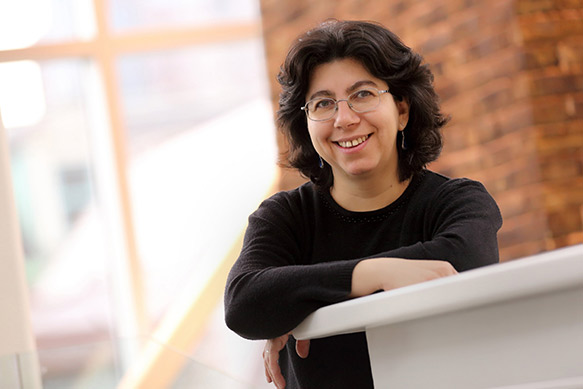
Doina Precup is one of the computer scientists that Evans is welcoming to the HBHL tent. She is an associate professor of computer science and her research interests involve artificial intelligence and the ways in which AI and complex computational methods might contribute to the world of medicine.
When you think of machine learning, consider IBM’s Watson and how it became highly adept at poring through massive amounts of data to become spectacularly proficient at a precisely defined task – winning Jeopardy!
“Diseases can be highly complex and treatments aren’t always straightforward,” Precup says. “Different subgroups of a disease respond well to certain treatments, while others don’t. Sometimes, treatments need to be adjusted over time. And people don’t all respond [to the same treatments] the same way. Everyone is unique, with their own case histories. This is where machine learning can help.
“By digging through reams of data, we can try to pinpoint how one patient is different from another patient that a treatment worked more effectively for. Machine learning can help pave the way for more personalized approaches. The hope is to build core tools that can be deployed in a hospital setting for patient care.”
Evans offers an example of how the work of his lab recently profited from both advanced computational methods and open science practices.
“There is a public database for Azheimer’s disease called ADNI [Alzheimer’s Disease Neuroimaging Initiative]. The data is collected across dozens of sites throughout the U.S. and put in the public domain. Anybody can get at it. Members of my lab downloaded that data and started to explore how the disease might propagate through the brain.” The data examined included more than 7,700 brain images of Alzheimer’s patients at different stages of the disease, along with cognitive tests and blood and cerebrospinal fluid samples.
“It revealed some very interesting findings,” says Evans. According to the McGill team’s work, the first physiological sign of Alzheimer’s disease is typically a decrease in blood flow in the brain, followed by an accumulation of the protein amyloid.
“The buildup of [amyloid] in the brain isn’t because of over-production, it’s because of under-clearance. If you don’t sweep it away, it builds up. So, that leads you to the perspective that, there’s no point in designing a drug that targets the synthesis of amyloid, because it’s not being over-produced. You have to look at the mechanisms for clearing the stuff away. That might be the glymphatic system, which is like a lymph system for brain – it sweeps away the debris and junk. If that isn’t working, you get the buildup of the protein, and you get the disease.
“That’s a hypothesis that will be tested by others now,” says Evans. “All of this came from publicly available data that was free to us. That just didn’t happen 20 years ago.
“We’re the beneficiaries of open science and we contribute to that vision as well,” says Evans. “Along with colleagues in Germany, we built a brain atlas called BigBrain.” The world’s first 3D atlas of an entire human brain and its microscopic structures, BigBrain is available to all for research purposes. “It’s been downloaded by 25,000 people around the world,” says Evans. “We take [from open science] and we give back.”
Probing plasticity
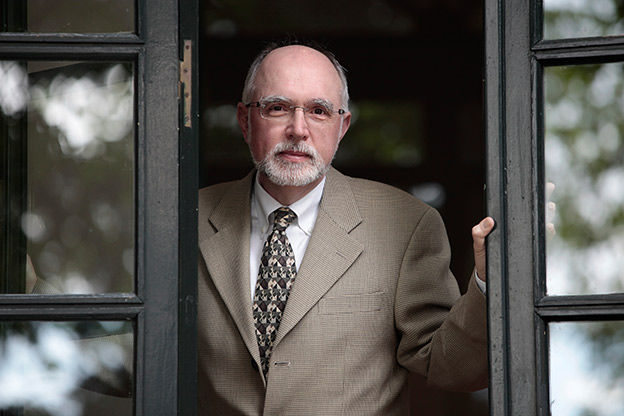
HBHL won’t just be looking at brains that are besieged by disease. Robert Zatorre, a professor of psychology, and neurology and neurosurgery, leads HBHL’s Dynamic Brain Project. His focus will be brain plasticity – how brains learn and why some brains are better able to recover from injuries or disorders than others.
“There is a lot of talk about brain stimulation these days and a lot of it is nonsense,” says Zatorre, “but that doesn’t mean that this isn’t a serious area of research.” What’s needed are better controlled studies combining brain stimulation with imaging and other techniques, which HBHL will support. Some existing studies on electrical brain stimulation have pointed to intriguing (albeit fleeting) improvements in memory function, for instance.
“These studies point to possible applications that could be developed, so we need to look at that carefully,” says Zatorre.
His own research has pointed to the complexity of learning. Last year, Zatorre led a research team that tracked a group of young adults learning to play the piano. Their brains were scanned before and after they took part in six weeks of musical training.
“When we looked at the brain activity in these people before the teaching began, we were able to predict who would be able to learn more quickly,” says Zatorre. Some brains seem to be better equipped than others to learn certain types of things. “We need to gain a better understanding of these predispositions so we can design more appropriate forms of training according to individual needs.”
McGill epigenetics pioneer Michael Meaney will lead HBHL’s Population Neuroscience and Brain Health component. Other leading McGill experts will play important roles on HBHL subcommittees.
Precup will head the NeuroHub, the advanced analytic platform that will support much of HBHL’s work. Transcultural psychiatry expert Lawrence Kirmayer, BSc’74, MDCM’78, will oversee social sciences. Gustavo Turecki, PhD’99, an authority on suicide, and Lesley Fellows, BSc’90, MDCM’96, an expert on decision-making, will co-lead HBHL’s clinical translational efforts. Brigitte Kieffer, a top authority on the use of animal models for psychiatric research, will lead the animal model work. The Neuro’s Edward Fon, whose research focuses on Parkinson’s disease and neuronal degeneration, heads the cellular and tissue mechanisms subgroup.
Guy Rouleau will lead HBHL’s Mechanisms of Neurodegenerative Disease program. Using neuroinformatics, Rouleau and his colleagues will focus on the brains of individuals known to carry disease-associated genes. “What we hope to accomplish is to identify molecules and compounds that have a significant effect on the disease models we have. We want to be able to point to specific mechanisms in the brain, so that industry can follow up on that and develop effective new drugs.”
Social science meets neuroscience
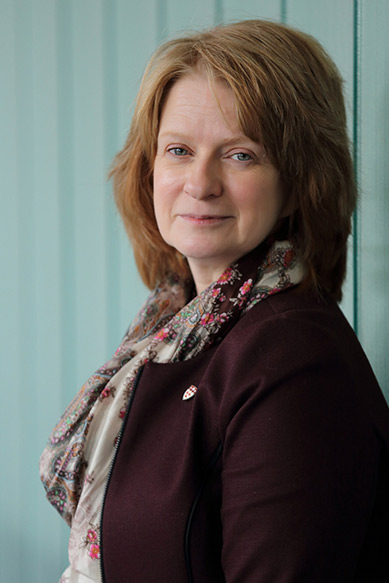
Another group of researchers who will be playing a key role in HBHL are social scientists.
“What we’ve learned from epigenetics experts like Michael Meaney, is that social circumstances can lead to epigenetic changes and make people more or less susceptible to certain diseases,” says McKinney. “This is where the social science component [of HBHL] is extremely important, to get a better understanding of that. If you look at suicide rates among teenagers, why are some groups more susceptible? Socioeconomic factors certainly play a major role. There are policymaking implications to all this.
“Working with communities is extremely important,” says McKinney. “Examining their environments and seeing what their needs are. That’s why a significant part of our CFREF funding will be directed towards public outreach. We want to share our findings with the public. We want them to be involved with what we’re doing and to understand what we’re doing.”
“We want to develop a better understanding of the cultural influences on normal brain development. That could have huge societal implications,” says Evans. “All of us are bombarded, our children in particular, with social media and the vast amounts of information that constantly stream in on our digital devices. To what extent are people’s brains being modified by the electronic environment that we all now live in?”
“We expect that we’ll be breaking down barriers and addressing specific questions by having a multidisciplinary approach,” says McKinney. “So, we might see someone doing genetics working with a medical imaging expert and some people from the social sciences.”
“I carefully avoid using the word ‘cure,’ but ‘treatment?’ Treatment is a continuum,” says Evans of the impact he expects HBHL to make in the years ahead. “Once we better understand how the brain works at the level of systems and circuitry, we can determine how to interfere with an abnormal mechanism in a constructive way. That’s true across all these disorders.
“We will be able to [help identify] interventions that improve the quality of life [for people] with a number of neurodegenerative and neurodevelopmental disorders,” says Evans. “We will make significant contributions on that front. That is something I’m confident about.”
